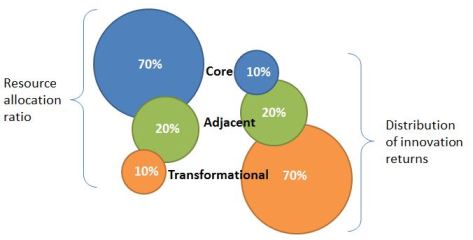This is my third post in the trilogy where I shed some light on the formula for successful innovation. I promised you the post on Thursday the 14th, but as with any innovation, sometimes new business opportunities and private appointments such as kid’s school graduation might come in between. Influenced by an article in Harvard Business Review, May 2012 I will discuss how innovation pays the bill, and for all of us who are interested in innovation, what can be more exciting?
In my first post about the formula for successful innovation, I talked about three innovation investment levels and the average resource allocations [link to post];
- Core innovations: 70%
- Adjacent innovations: 20%
- Transformation innovations:10%
If you just guessed the distribution of total returns on the above investment ratios, what would your best guess be? Well, not too surprisingly, the 80/20 rule is also valid here.
In a study of companies in the industrial, technology, and consumer goods sectors, a correlation can been seen between investment ratios and the distribution of innovation returns reflected in the share price. Among high performers that invest in all three levels of innovation, surveys reveal that the return ratio is the inverse of resource allocation. Companies that allocated according to the above investment ratios outperformed their peers, typically realizing a P/E premium of 10% to 20%.
Most companies are oriented toward core innovation, and must continue to be, given the risk involved in adjacent and transformational initiatives. But these results stress the importance for companies of managing total innovation ratios.
The above ratio of investment and resource allocation ratio is not a magic formula but an average figure based on cross-industry and cross-geography analysis. The right ratio will differ depending on things such as industry, level of business maturation and competitive market situation.
If your role is VP for R&D or President and CEO of a company, and you have overall responsibility for the innovation and resource allocation ratio, you should sit down and think about how your company has distributed its investment money on core, adjacent and transformational innovations over the last couple of years. More important , of course, is how you want to distribute the money in the future to maintain long-term competitiveness.
Different ambitions will result in different resource allocations resulting in different bottom line results. So my advice is to start to tag your investments with investment ambitions categories prior to any investment decision being made. Doing that will give you a grasp of your whole product investment portfolio—and the product returns can be estimated and calculated. This is something both management and investors will like.
Please also make sure you have the 5 key areas of management in place to serve the three levels of innovation ambition; Talent, Integration, Funding, Pipeline and Metrics [link to post]
It’s Sunday evening and the weather in Sweden this day has offered rain, sun and wind in very innovative combinations. This Sunday evening we had the last football training session for the semester, and as manager, I am amazed to see the sparkling energy in these 8 years old kids. These kids remind me about one thing that make any kid a hero during training or a game, and that one thing is also so important when talking about innovation—passion.
You may have the right ambitions and the right allocations, but without passion from your employees, you will achieve absolutely nothing.
Tomorrow I will go on vacation, and I am looking forward to spending lots of time with my family. My three kids will continue to remind me that passion for what you do and want to achieve is the fastest and safest way to success.
Make sure you turn off the push email function on your smartphone for a while. Let your brain be influenced by other things than work for a short while, and I guarantee that your brain will be re-charged with lots of new energy and new thoughts, both of which are the most important ingredients for creativity and innovation.
